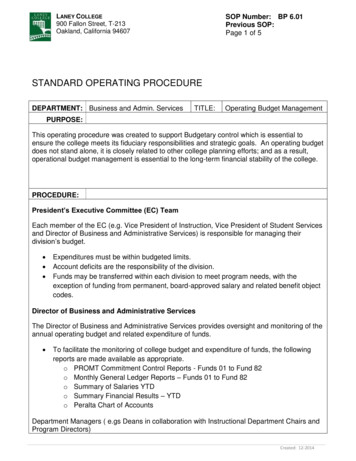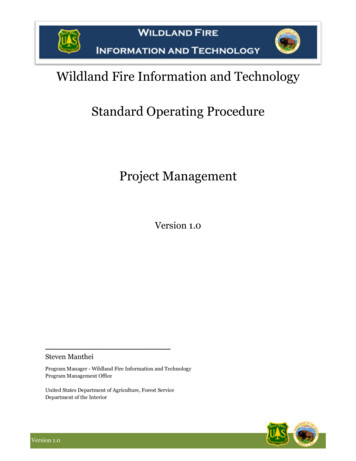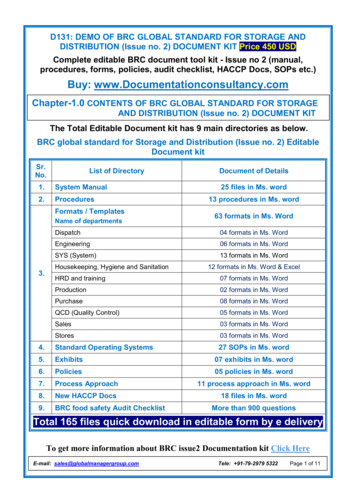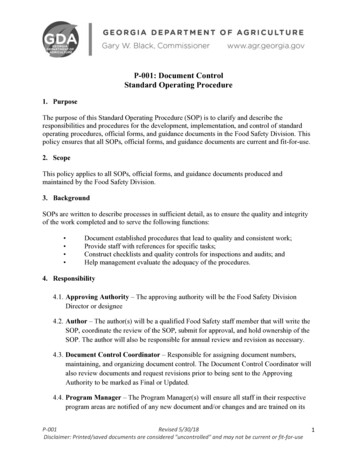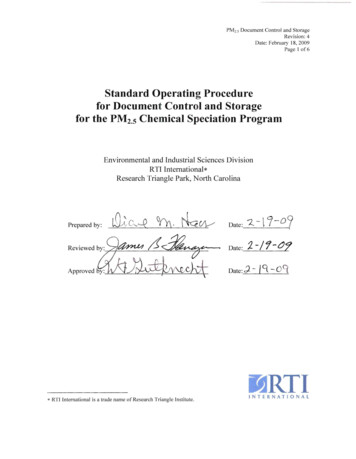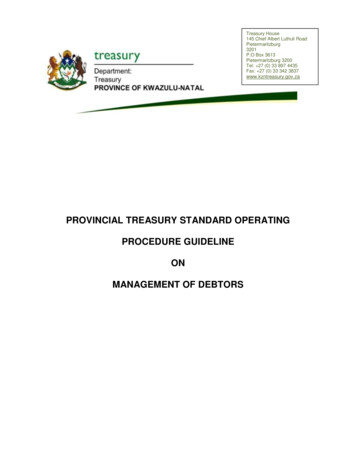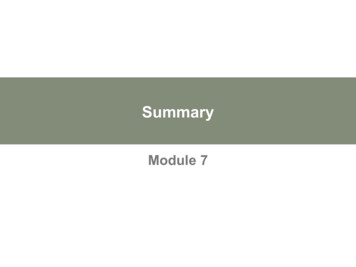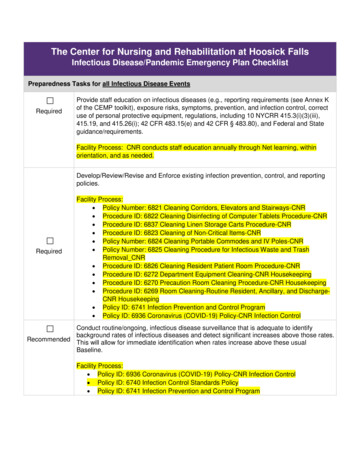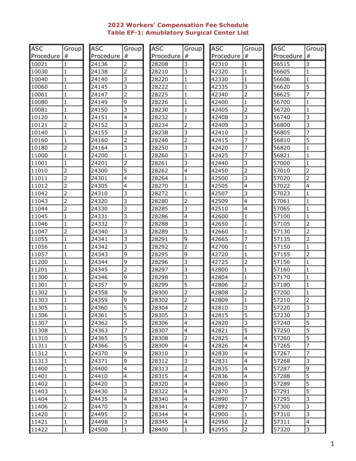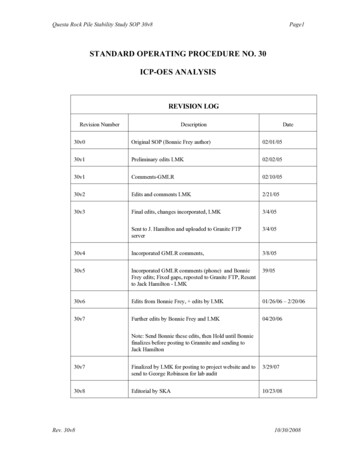
Transcription
Questa Rock Pile Stability Study SOP 30v8Page1STANDARD OPERATING PROCEDURE NO. 30ICP-OES ANALYSISREVISION LOGRevision NumberDescriptionDate30v0Original SOP (Bonnie Frey author)02/01/0530v1Preliminary edits LMK02/02/0530v1Comments-GMLR02/10/0530v2Edits and comments LMK2/21/0530v3Final edits, changes incorporated, LMK3/4/05Sent to J. Hamilton and uploaded to Granite FTPserver3/4/0530v4Incorporated GMLR comments,3/8/0530v5Incorporated GMLR comments (phone) and BonnieFrey edits; Fixed gaps, reposted to Granite FTP, Resentto Jack Hamilton - LMK39/0530v6Edits from Bonnie Frey, edits by LMK01/26/06 – 2/20/0630v7Further edits by Bonnie Frey and LMK04/20/06Note: Send Bonnie these edits, then Hold until Bonniefinalizes before posting to Grannite and sending toJack Hamilton30v7Finalized by LMK for posting to project website and tosend to George Robinson for lab audit3/29/0730v8Editorial by SKA10/23/08Rev. 30v810/30/2008
Questa Rock Pile Stability Study SOP 30v81.0Page2PURPOSE AND SCOPEThis Standard Operating Procedure (SOP) provides technical guidance and proceduresfor the analysis of solid and water samples by Inductively Coupled Plasma OpticalEmission Spectroscopy (ICP-OES), specifically on a PerkinElmer Optima 5300 DV.This SOP addresses sample preparation, equipment used, laboratory and instrumentprocedures, personnel responsibilities, and quality control.The primary purpose for conducting metals analysis by ICP-OES for this project isbecause it provides a stable instrument that can handle complicated matrices of up to 5%dissolved solids as is expected for many of the Molycorp rock pile samples. A secondarypurpose for analyzing these samples by ICP-OES is to screen them before trace elementanalysis that will be conducted by ICP-MS. This screening process is necessary toprevent overloading the ICP-MS detector and to reduce the amount of maintenancerequired when analyzing high-solids samples.Analysis by ICP-OES will follow US EPA Method 6010 – Inductively Coupled PlasmaAtomic Emission Spectrometry. Sample digestion will follow Briggs method (seeReferences section). Any deviations from these methods will be noted in this SOP.Currently 39 elements are targeted for ICP-OES analysis. US EPA Method 6010bprovides details for analysis of 30 of these elements: aluminum, antimony, arsenic,barium, beryllium, cadmium, calcium, chromium, cobalt, copper, iron, lead, lithium,magnesium, manganese, mercury, molybdenum, nickel, phosphorus, potassium,selenium, silica, silver, sodium, strontium, thallium, tin, titanium, vanadium and zinc.The NMBMMR Chemistry Lab (hereafter referred to as the Chem Lab) has added thefollowing elements for analysis by ICP-OES: bismuth, gallium, sulfur, tungsten, yttriumand zirconium. Boron, lithium, mercury and thallium are included in Method 6010b butwill not be included in the Chem Lab ICP-OES analysis package. The following targetanalytes will be analyzed by ICP-MS additionally or instead of ICP-OES: arsenic,beryllium, cobalt, gallium, lead, molybdenum, nickel, rubidium, silver, tellurium,thorium, uranium, vanadium and the rare earth elements. Because of the volatile natureof silica during open-vessel digestion, no silicon analyses will be completed on solids byICP-OES. Table 1 (Appendix 1) lists the target analytes, their wavelengths, theirexpected method detection limits (MDLs), and their plasma viewing positions.2.0RESPONSIBILITIES AND QUALIFICATIONSThe Laboratory Manager, under the direction of the Team Leader and CharacterizationTeam, will have the overall responsibility for implementing this SOP. They will beresponsible for assigning appropriate staff to implement this SOP and for ensuring thatthe procedures are followed accurately.All personnel performing these procedures are required to have the appropriate health andsafety training. In addition, all personnel are required to have a complete understandingof the applicable procedures described within this SOP and to receive specific trainingRev. 30v810/30/2008
Questa Rock Pile Stability Study SOP 30v8Page3regarding these procedures, if necessary. Personnel trained to use the EnvironmentalExpress HotBlock and the associated hazardous acids will undertake the proceduresoutlined in the sample preparation section of this SOP. Qualified personnel include theChem Lab manager, lab technicians, and selected student workers. The Chem Labmanager and lab technicians will undertake the procedures outlined in the ICP-OESsection of this protocol when conducting analyses on the PerkinElmer Optima 5300 DV.All environmental staff and assay laboratory staff are responsible for reporting deviationsfrom this SOP to the Team Leader.3.0DATA QUALITY OBJECTIVESThis SOP addresses the following objectives in the data quality objectives outlined in the"Geological and Hydrological Characterization work plan at the Molycorp Questa Mine,Taos County, New Mexico”:1. To provide principle investigator (PI) researchers with quality analyticallaboratory data that have been verified and validated.2. To provide PI researchers with analytical data that have appropriate detectionlimits and that have been conducted in accordance with acceptable procedures.3. To provide PI researchers with confidence that the data have been generated andtransferred to the centralized database utilizing the procedures outlined in theproject SOPs.4.0RELATED STANDARD OPERATING PROCEDURESThe procedures for providing analyses by ICP-OES set forth in this SOP are intended foruse with the following SOPs: SOP 1 Data management (including verification and validation)SOP 2 Sample management (including chain of custody) SOP 5 Sampling outcrops, rock piles, and drill core (solids) SOP 8 Sample preparation (solids) SOP 15 Surface water and seep sampling SOP 16 Ground-water sampling SOP 22 Analytical data validation SOP 31 ICP-MS analysis SOP 36 Sample preservation, storage, shipping and custody SOP 68 Water analyses SOP 78 Humidity cell testingRev. 30v810/30/2008
Questa Rock Pile Stability Study SOP 30v8 5.0Page4SOP 79 Humidity cell sample preparationEQUIPMENT LISTThe following materials and equipment are needed for sample preparation and analysisby ICP-OES:5.1 Preservation of water samples: Dropper bottle filled with concentrated, ultra-high-purity nitric acid (HNO3) to beadded by laboratory personnel 16 hours prior to performing the sample analysis.5.2 Briggs four-acid digestion for solid samples (hereafter referred to as the Briggsmethod) Environmental Express 36-well HotBlockTM SC100Two 18-place polycarbonate racks for HotBlock36 60-mL Teflon HotBlock vessels with capsDigital plastic coated temperature probeperchloric acid (HClO4) fume hoodMilestone Duopur acid distillation unitMilestone TraceClean acid washerOhaus Voyager balance accurate to four decimal placesStainless steel laboratory scoopsTrace-element grade HNO3, HClO4, hydrofluoric acid (HF) and hydrochloric acid(HCl)Water purified to 18.2 MOhm by reverse osmosis, hereafter referred to as RO waterSafety gear (Safety goggles, lab coat, etc.)Whatman ashless filters (grade 40)Polypropylene funnelsFunnel holders50-mL graduated centrifuge tubes14-mL graduated centrifuge tubes60-place plastic centrifuge tube rackNational Institute of Standards and Technology (NIST) Standard Reference Material(SRM) 2780 (Appendix 2), Hard Rock Mine WasteMolycorp Capulin sample 104, to be treated as an ongoing laboratory control sampleStandard solutions for matrix spikesLaboratory notebook and indelible pens5.3 Analysis for metals and other cations PerkinElmer ICP-OES Optima 5300 DV Computer-controlled emission spectrometer with background correction Echelle grating optical system Radial and axial viewing capabilityRev. 30v810/30/2008
Questa Rock Pile Stability Study SOP 30v8 Page5 Radio-frequency generator compliant with FCC regulations High purity argon gas Volumetric flasks and pipettesUltrapure HNO3 and HClRO waterSingle element standard solutions, mixed calibration standards, calibration blank (forestablishing calibration curve), method blank (used to identify contamination fromsample preparation), initial calibration verification, continuous calibrationverification, internal standard (scandium), interference check solution, and spikingstandards6.0PROCEDURESAnalysis by ICP-OES will follow US EPA Method 6010b – Inductively Coupled PlasmaAtomic Emission Spectrometry. Sample digestion will follow Briggs method. Anydeviations from these methods will be noted in this SOP.6.1Sample preservation and preparationSample collection, preservation, and preparation techniques are critical for successfulanalysis on any laboratory instrument. For this reason, criteria in SOPs 5, 8, 15, 16, 36,78, and 79 must be accurately followed and documented during sample preservation andpreparation.6.1.1 Preparation of water samplesWater samples must be filtered to less than 0.45 um and preserved in the field by coolingto less than 4 degrees C within four hours of sampling. Lab personnel will acidify watersamples to a pH less than 2 with ultrapure HNO3 16 hours before ICP-OES analysis(USEPA Method 200.7). Acid preservation is not necessary in the field. Acidpreservation will be done in the laboratory as described above. Water samples will beanalyzed initially without dilutions. If concentrations are found to be above the highestcalibration standards, subsequent dilutions will be required and appropriatelydocumented.Preparation of samples from humidity cells need alternative and additional handling thatis detailed in SOPs 78 and 79.Rev. 30v810/30/2008
Questa Rock Pile Stability Study SOP 30v8Page66.1.2 Preparation of solid samplesSolid samples will be digested by HotBlock following the Briggs digestion method, afour-acid method requiring HCl, HClO4, HNO3 and HF. The procedure takesapproximately two days and must be completed under a perchloric-acid fume hood.Details of each digestion will be recorded in a laboratory notebook designated forMolycorp digestions.Prior to digestion, solid samples must be ground to a powder following SOP 8. Samplesare then dried overnight at 110 degrees C, and 0.200 g of sample is weighed into a TeflonHotBlock vessel. The sample names and weights are recorded in the laboratory notebook.The sides of the sample vessels are rinsed down with RO before adding reagents. Theinitial reagent mixture is 3 mL HCl, 2 mL HNO3, 1 ml HClO4, and 2 ml HF. Thesample mixtures are heated on the HotBlock at 110 degrees C under an HClO4 fumehood until the solution is dried completely. The samples are then removed from the heatuntil they are cool to touch. Another milliliter of HClO4 and 2 mL of RO water areadded to each sample, and the solution is evaporated to dryness at 160 degrees C. Thesamples are cooled again, then 1 mL of aqua regia (3 parts HCl to 1 part HNO3) is addedto each sample and allowed to react for 15 minutes. A solution of 9 mL 1% HNO3 isadded to each sample, the vessel is capped, and the vessel is heated in a drying oven for 1hour at 95 degrees C. The solution is cooled again. If there is no evidence of remainingsolids, the samples are rinsed into 50-mL graduated centrifuge tubes and brought tovolume. These tubes will also serve as the permanent storage containers for the samples .Digested samples are then diluted at least 1:5 for ICP-OES analysis and at least 1:20 forICP-MS analysis. Subsequent dilutions may be required if analyte concentrations areabove the instrument’s linear range.6.2ICP-OES ProceduresPrior to sample analysis, interference corrections will be established and an initialinstrument performance demonstration must be documented and kept on file. Thislaboratory document will include instrument detection limits (IDLs), method detectionlimits (MDLs), and the linear dynamic range of the instrument. A list of MDLs areincluded in Table 1, Appendix 1. These tasks are detailed in Method 6010b, but a reviewis provided in the quality control section of this SOP. QA/QC procedures are conductedin accordance with SOP 22 Analytical Data Validation.The following solutions must be prepared prior to analysis: A sample probe rinse solution of 1% ultrapure HNO3 An internal standard solution of 10 ppm Sc in 1% ultrapure HNO3 A calibration blank and calibration standards for a three-point calibration A calibration check blank solutionRev. 30v810/30/2008
Questa Rock Pile Stability Study SOP 30v8 Page7Calibration verification solutions made from stock solutions independent of thecalibration standard stock solutionsAn interference check solution, when necessary (see quality control section)Water samples preserved with 1% ultrapure HNO3 can be analyzed directly unlessearlier analyses suggest dilutions are necessary. Solid samples digested by Briggsmethod must be diluted at least 1:5 with RO water.All samples will be analyzed with a Scotts spray chamber and a gem cone nebulizer.7.0MAINTENANCEMaintenance is completed on daily and periodic levels. Although occasional users of theICP-OES will only conduct daily maintenance, they must be aware of how recentlyperiodic maintenance tasks have been conducted.Immediately after installation of the ICP-OES, the wavelengths were aligned by aPerkinElmer technician. This maintenance item will be repeated by a PerkinElmertechnician whenever the spectrometer is serviced.Periodic maintenance includes an argon purge after the argon tank has been disconnectedfrom the spectrometer. When running the instrument for the first time after the argontank has been reconnected, an argon purge is necessary and the spectrometer must bewarmed up for 70 minutes. After this warm-up, turn on the pump to flush the lines. If amonth has passed since last firing the torch, purge the plasma, auxiliary and nebulizer gaslines before lighting the plasma. If the last firing occurred within the last month, the gaslines will be purged automatically when the plasma is turned on.Several other periodic tasks are required after lighting the torch; however, the plasma mustbe allowed to equilibrate for about 30 to 60 minutes before proceeding with these tasks. Thenebulizer flow and plasma power must be optimized every month, especially when high saltsolutions are analyzed on a regular basis, and whenever maintenance on the sampleintroduction section has been conducted. A solution of As (5 ppm), Mn (1 ppm), Sc (0.1ppm), K (5 ppm), and Ba (0.1 ppm) is pumped through the torch during optimization.Optimization involves the adjustment of the plasma power between 1300 and 1400 W whileobserving the element’s signal strength in the continuous graphics window. Each of thesefive elements will react differently to the power adjustments. The power that provides thebest signal for all five elements must be established and that wattage used during analysis.Next, adjust the nebulizer flow incrementally between 0.90 and 0.60 L/min for radial andaxial plasmas, in that order. After observing each element’s change in intensity, the bestflow will be established and used for the analyses.Once a month or after torch maintenance, the plasma view must be realigned. The torchis first aligned in the radial view while pumping a 10 ppm solution of Mn. The “alignview” command is given from the spectrometer control window. Record the alignmentsettings and peak intensity upon completion of the alignment. Repeat this procedure forthe axial view while pumping a 1 ppm solution of Mn.Rev. 30v810/30/2008
Questa Rock Pile Stability Study SOP 30v8Page8All pump tubing must be changed on a weekly basis.The Background Equivalent Concentration must be checked daily.The mercury lamp must be realigned daily. Pump a solution of 1% ultrapure HNO3through the sample introduction system and give the “Hg realign” command from thespectrometer control window. The final intensity, which must be at least 7 million countsper second, must be recorded upon completion of the realignment.8.0LABORATORY SAFETYSeveral safety aspects must be observed by all laboratory personnel: the proper and safehandling of acids, especially perchloric acid and hydrofluoric acid, and all other generalsafe laboratory practices detailed in New Mexico Tech’s Laboratory Safety Manual.Hydrofluoric acid and perchloric acid are among the most dangerous chemicals used inthe Chem Lab. Special precautions must be taken during their use. The most importantand basic of these precautions are posted in the vicinity of the perchloric acid fume hood,which will be used for all HotBlock procedures. Basic first aid (instruction posted nearfume hood) should be administered if any personnel become exposed to these acidsthrough skin contact, eye contact, inhalation, or ingestion.9.0QUALITY ASSURANCE/QUALITY CONTROLThe analyst must make an initial demonstration of the ability to generate acceptableaccuracy and precision following EPA Method 6010b. This demonstration will result inthe documentation of detection limits, initial precision and recovery, linear dynamicrange for each wavelength used, and the first analysis of an ongoing laboratory controlsample with a reference sample.In addition, quality control samples will be analyzed including:9.1 samples used to evaluate solid sample preparation methods. samples to evaluate analytical precision.Interference correctionsTwo techniques will be employed to correct interferences on the PerkinElmer Optima5300 DV. The first is a multi-component spectral fitting (MSF) file. To develop this file,a single element standard of each element of interest is diluted with 1% ultrapure HNO3and analyzed on the instrument. After the run, the peaks and baselines are reset, theblanks are identified as global blanks, any interfering elements are identified forRev. 30v810/30/2008
Questa Rock Pile Stability Study SOP 30v8Page9subsequent subtraction, and the elements of interest are identified as analytes. Thesecorrections are tested with interferent-check standards for five consecutive days to within20 percent of the target concentration. These checks must be completed every six months(EPA Method 6010B). After this file has been tested sufficiently, an inter-elementcorrection (IEC) file may be developed. An interference check solution will be run everysix months.The second interference correction test used is a dilution test and post-digestion spikedescribed in Method 6010B. This test will be performed periodically to check for matrixinterferences:1. When completing initial analyses of the Molycorp laboratory control sample andNIST SRM 2780 (Appendix 1).2. When completing the first analyses of Questa samples.3. When analyzing an unusual sample.9.2Detection limitsInstrument detection limits (IDLs) and method detection limits (MDLs) will be calculatedfor the ICP-OES following the USEPA SW-846 manual, Chapter 1, and USEPA Method6010b and kept as in-house documentation. Only the MDLs will be reported in anupdated draft of SOP 30.The IDL is estimated by taking the average standard deviations of three runs of sevenblank measurements each on three nonconsecutive days. An IDL analysis will beconducted annually.MDLs will be calculated for all elements from standards that are 3 to 5 times theexpected MDLs. Calculations of this parameter will follow US-EPA Manual SW-846,Test Methods for Evaluating Solid Waste, Physical/Chemical Methods Chapter 1.Subsequent sample concentrations below the reported MDL will not be reported as datapoints, but as less-than values. New MDLs will be determined annually.9.3.1 Internal standardScandium is the internal standard being used on this instrument. If the intensity of theinternal standard falls below 30 percent for a particular sample, a matrix effect must besuspected. To correct the problem, first recalibrate the instrument and reanalyze thesample to be sure the problem was not the result of instrument drift. If the problem hasRev. 30v810/30/2008
Questa Rock Pile Stability Study SOP 30v8Page10still not been corrected, dilute the sample 1:5 and reanalyze, repeating analysis withincreasing dilutions until the internal standard is within 30 percent of the blank intensity.9.4 Quality control samplesReagent blanks, sample duplicates, matrix spikes, and NIST standards will be prepared atthe digestion level for solids. For each HotBlock batch, one reagent blank will beprepared per every 10 samples and one duplicate and one NIST standard will be preparedper every 20 samples. The Molycorp ongoing control sample will be analyzed once amonth to monitor sample precision throughout the project. Sample spikes will beprepared before any Molycorp samples are analyzed and whenever a particular samplesdoes not digest easily or produces unusual data. The following guidelines should be metfor these quality control solutions: Reagent blanks should be less than the method detection limit. The relative percent difference of duplicates and standards should be within 15percent. The percent recovery of matrix spikes should be within 25 percent.Reagent blanks, sample duplicates and matrix spikes will be prepared for the analysis ofwater samples and should meet the guidelines listed above.ICP-OES runs will include an initial calibration verification solution and a blank solutionat the beginning and end of every run. A calibration verification solution will beanalyzed after every 10 samples throughout the run. The verification measurements mustbe within 10 percent of the expected value. If they are not, the problem should becorrected before continuing with analyses.During the analysis, every element will be analyzed in triplicate for every sample andused by the instrument to calculate relative standard deviation (RSD) automatically.Analyses above the method detection limit with a RSD greater than 5 % should bediscontinued and the problem corrected before continuing with the analyses.From these quality control samples, the following parameters can be calculated toevaluate precision and accuracy within the parameters listed above:1) Relative percent difference (RPD) 100 * [(A-B)/((A B)/2)], where A measuredconcentration of a sample and B measured concentration of sample replicate.Rev. 30v810/30/2008
Questa Rock Pile Stability Study SOP 30v8Page112) Percent recovery (%R) of spiked samples 100 * (xs-xu) / K, where xs measuredconcentration of the spiked sample, xu measured concentration of the unspiked sample,and K known concentration of spike.3) Percent recovery (%R) for standard reference materials 100 * (x) / K, where x measured concentration of the NIST standard or ICV, and K known concentration ofNIST standard or ICV.4) Standard deviation – calculated from the NIST standard in the case of solid analysisand calculated from the ICV in the case of water samples.9.5 Ion balance for water samplesMajor and minor cations analyzed by ICP-OES and ICP-MS (SOP 31) will be used inconjunction with anions analyzed by IC (SOP 68) to calculate ion balance as described inSOP 22. The ion balance calculations will be performed within the database. An ionbalance report will be provided to the lab manager, project manager and auditor.10.0 DOCUMENTATION Documentation to track samples through the laboratory will be as follows: Upon sample delivery to the Chem Lab, a chain of custody form will be signed bythe person delivering the samples and by the person receiving the samples. Inaddition to the samples and the chain of custody form, a copy of the conductivity,pH, and alkalinity field data will be delivered to the lab. Samples will be logged in to the Chem Lab's log book detailing the date received,Molycorp sample ID, lab ID and required analyses. The lab ID will be written on sample bottles and bags with black Sharpie(indelible pen). Throughout the digestion process, the lab ID for solid samples will be transferredto the Prep Lab notebook, to the bottles containing the digested sample, and to thebottles containing the diluted sample. The sample ID and lab ID will be entered into the sample introduction file on theICP-OES software before analysis begins. The numeric results of the analyses are reported to three significant figures.Rev. 30v810/30/2008
Questa Rock Pile Stability Study SOP 30v8Page12 After analysis, an electronic version of the data will be transferred to theMolycorp Project database. In addition, an analysis report detailing the samples transferred and the quality ofthe analyses will automatically be sent to the project manager, the Chem Labmanager and the project auditor. Any unused solid sample material will be returned to the sampler with the properchain of custody forms filled out and signed. Water samples and sample digestate will be stored in the Chem Lab for a periodof 12 months after digestion. After that period, they will be disposed of followingthe protocols of the New Mexico Tech safety office.11.0 FORMSForms are not applicable to this SOP as the data is output by the machinery in the form ofExcel spreadsheets that are directly entered into the Molycorp Database.12.0 DATA ANALYSIS AND VERIFICATIONIn addition to the checks conducted by the analyst during and after an ICP-OES run toassure proper calibration and instrument stability, an automated analysis report will begenerated during the data transfer to the project database. This report will be sentautomatically by email to the lab manager, project manager and auditor. A filter will beset up to flag and hold any analyses that do not meet project specifications so the samplecan be reanalyzed, if necessary. The report will include failures of the calibration checks,blanks, duplicates, and standard reference materials, as well as failures of relative percentdifference, percent recovery, and relative standard deviations.Data provided to the customer will include a data quality report documenting that allaccepted data has met the quality protocols detailed in this SOP. All NIST standard andICV data will be entered into the Molycorp Project database as samples and will be usedto generate standard errors on solid and water data tables. Standard deviation errors willbe included with all data reports.The database technician will be responsible for verifying that the data has transferred tothe database correctly.13.0 REFERENCESRev. 30v810/30/2008
Questa Rock Pile Stability Study SOP 30v8Page13U.S. Environmental Protection Agency, 1996, Inductively Coupled Plasma-AtomicEmission Spectrometry, Method 6010B, Revision 2.0, SW-846 Manual, 3rd edition,Office of Solid Waste and Emergency Response.Briggs, P.H., (2001 version) The Determination of Forty Elements in Geological andBotanical Samples by Inductively Coupled Plasma-Atomic Emission Spectrometry, U.S.Geological Survey Open File Report 02-223-G, Analytical Methods for ChemicalAnalysis of Geologic and Other Materials, U.S. Geological Survey.U.S. Environmental Protection Agency, 1987, Test Methods for Evaluating Solid Waste,Physical/Chemical Methods, SW-846 Manual, 3rd edition, Office of Solid Waste andEmergency Response.U.S. Environmental Protection Agency, 2001, Trace Elements in Water, Solids, andBiosolids by Inductively Coupled Plasma-Atomic Emission Spectrometry, Method 200.7,EPA-821-R-01-010, Revision 5.0.Certificate of Analysis, Standard Reference Material 2780, Hard Rock Mine Waste,National Institute of Standards & Technology, January 31, 2003.Boss, C.B., Fredeen, K.J., Concepts, Instrumentation and Techniques in InductivelyCoupled Plasma Optical Emission Spectrometry, PerkinElmer, 2004.New Mexico Tech Safety Manual.Rev. 30v810/30/2008
Questa Rock Pile Stability Study SOP 30v8Page14APPENDIX 1. Table 1Table 1. Analytes and their associated wavelengths,detection limits (ppm), linear dynamic ranges (ppm)and plasma viewing positions on the PerkinElmerOptima 5300 DV.AnalyteWavelength(nm)Methoddetectionlimits (water)Methoddetectionlimits 9plasma gasplasma gasSc361.383internal standardinternal standardAxialSc361.383internal standardinternal standardRadialRev. 30v8100AxialRadial10/30/2008
Questa Rock Pile Stability Study SOP 30v8Page15APPENDIX 2. Certificate of analysis, NIST Standard ReferenceMaterial 2780National Institute of Standards & TechnologyCertificate of AnalysisStandard Reference Material 2780Hard Rock Mine WasteThis Standard Reference Material (SRM) is intended for use in the evaluation of methodsand for the calibration of apparati used to determine heavy metals and other elements inhard rock mine waste and materials of a similar matrix. SRM 2780 is composed ofmaterial collected from a waste pile of an abandoned mine site near Silverton, CO. A unitconsists of approximately 50 g of material of which 90 % passes a 150 µm (No. 100)sieve.Certified Values and Uncertainties: Certified mass fraction values for 12 elements arelisted in Table 1. A NIST certified value is a value for which NIST has the highestconfidence in its accuracy in that all known or suspected sources of bias have beeninvestigated or accounted for by NIST. All values are reported as mass fractions [1], on adry mass basis (see Instructions for Drying), and are based on measurements using asample mass of at l
STANDARD OPERATING PROCEDURE NO. 30 ICP-OES ANALYSIS REVISION LOG Revision Number Description Date 30v0 Original SOP (Bonnie Frey author) 02/01/05 30v1 Preliminary edits LMK 02/02/05 30v1 Comments-GMLR 02/10/05 30v2 Edits and comments LMK 2/21/05 30v3 Final edits, changes incorporated, LMK Sent to J. Hamilton and uploaded to Granite FTP
